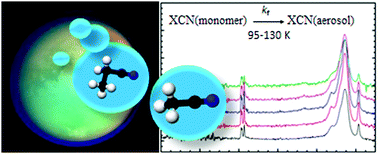Infrared characterisation of acetonitrile and propionitrile aerosols under Titan's atmospheric conditions†
Abstract
Pure, crystalline acetonitrile (CH3CN) and propionitrile (CH3CH2CN) particles were formed in a collisional cooling cell allowing for infrared (IR) signatures to be compiled from 50 to 5000 cm−1. The cell temperature and pressure conditions were controlled to simulate Titan's lower atmosphere (80–130 K and 1–100 mbar), allowing for the comparison of laboratory data to the spectra obtained from the Cassini–Huygens mission. The far-IR features confirmed the morphology of CH3CN aerosols as the metastable β-phase (monoclinic) ice, however, a specific crystalline phase for CH3CH2CN could not be verified. Mie theory and the literature complex refractive indices enabled of the experimental spectra to be modelled. The procedure yielded size distributions for CH3CN (55–140 nm) and CH3CH2CN (140–160 nm) particles. Effective kinetic profiles, tracing the evolution of aerosol band intensities, showed that condensation of CH3CH2CN proceeded at twice the rate of CH3CN aerosols. In addition, the rate of CH3CH2CN aerosol depletion via lateral diffusion of the particles from the interrogation volume was approximately 50% faster than that of CH3CN. The far-IR spectra recorded for both nitrile aerosols did not display absorption profiles that could be attributed to the unassigned 220 cm−1 feature, which has been observed to fluctuate seasonally in the spectra obtained from Titan's atmosphere.



 Please wait while we load your content...
Please wait while we load your content...